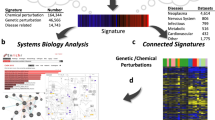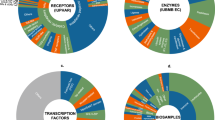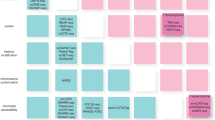Abstract
Research in signal transduction aims to identify the functions of different signaling pathways in physiological and pathological states. Traditional techniques using biochemical, genetic or cell biological approaches have made important contributions to our understanding of cellular signaling. However, the single-gene approach does not take into account the full complexity of cell signaling. With the availability of omics techniques, great progress has been made in understanding signaling networks. Omics approaches can be classified into two categories: 'molecular profiling', including genomic, proteomic, post-translational modification and interactome profiling; and 'molecular perturbation', including genetic and functional perturbations.
This is a preview of subscription content, access via your institution
Access options
Subscribe to this journal
Receive 12 print issues and online access
$259.00 per year
only $21.58 per issue
Buy this article
- Purchase on Springer Link
- Instant access to full article PDF
Prices may be subject to local taxes which are calculated during checkout




Similar content being viewed by others
References
Olsen, J.V. & Mann, M. Status of large-scale analysis of post-translational modifications by mass spectrometry. Mol. Cell. Proteomics 12, 3444–3452 (2013).
Serber, Z. & Ferrell, J.E. Jr. Tuning bulk electrostatics to regulate protein function. Cell 128, 441–444 (2007).
Choudhary, C., Weinert, B.T., Nishida, Y., Verdin, E. & Mann, M. The growing landscape of lysine acetylation links metabolism and cell signalling. Nat. Rev. Mol. Cell Biol. 15, 536–550 (2014).
Geiss-Friedlander, R. & Melchior, F. Concepts in sumoylation: a decade on. Nat. Rev. Mol. Cell Biol. 8, 947–956 (2007).
Hunter, T. The age of crosstalk: phosphorylation, ubiquitination, and beyond. Mol. Cell 28, 730–738 (2007).
Pawson, T. & Nash, P. Protein-protein interactions define specificity in signal transduction. Genes Dev. 14, 1027–1047 (2000).
Petschnigg, J., Snider, J. & Stagljar, I. Interactive proteomics research technologies: recent applications and advances. Curr. Opin. Biotechnol. 22, 50–58 (2011).
Teruel, M.N. & Meyer, T. Translocation and reversible localization of signaling proteins: a dynamic future for signal transduction. Cell 103, 181–184 (2000).
Alon, U. Network motifs: theory and experimental approaches. Nat. Rev. Genet. 8, 450–461 (2007).
Berger, B., Peng, J. & Singh, M. Computational solutions for omics data. Nat. Rev. Genet. 14, 333–346 (2013).
Joyce, A.R. & Palsson, B.O. The model organism as a system: integrating 'omics' data sets. Nat. Rev. Mol. Cell Biol. 7, 198–210 (2006).
Kolch, W. & Pitt, A. Functional proteomics to dissect tyrosine kinase signalling pathways in cancer. Nat. Rev. Cancer 10, 618–629 (2010).
Kristensen, V.N. et al. Principles and methods of integrative genomic analyses in cancer. Nat. Rev. Cancer 14, 299–313 (2014).
Rigaut, G. et al. A generic protein purification method for protein complex characterization and proteome exploration. Nat. Biotechnol. 17, 1030–1032 (1999).
Ong, S.E. & Mann, M. Mass spectrometry–based proteomics turns quantitative. Nat. Chem. Biol. 1, 252–262 (2005).
Lange, V., Picotti, P., Domon, B. & Aebersold, R. Selected reaction monitoring for quantitative proteomics: a tutorial. Mol. Syst. Biol. 4, 222 (2008).
Bisson, N. et al. Selected reaction monitoring mass spectrometry reveals the dynamics of signaling through the GRB2 adaptor. Nat. Biotechnol. 29, 653–658 (2011).
Zheng, Y. et al. Temporal regulation of EGF signalling networks by the scaffold protein Shc1. Nature 499, 166–171 (2013). Together with the paper by Bisson et al ., this study analyzes the signaling complexes proximal to EGFR during EGF signaling with SRM. It reveals the dynamics of different complexes, which play distinct roles in EGF signaling.
Gillet, L.C. et al. Targeted data extraction of the MS/MS spectra generated by data-independent acquisition: a new concept for consistent and accurate proteome analysis. Mol. Cell. Proteomics 11, O111.016717 (2012).
Collins, B.C. et al. Quantifying protein interaction dynamics by SWATH mass spectrometry: application to the 14-3-3 system. Nat. Methods 10, 1246–1253 (2013). This is the first successful example of the use of SWATH to address a biological question. It reveals the dynamics of 14-3-3 protein complexes in response to IGF1 stimulation.
Lambert, J.P. et al. Mapping differential interactomes by affinity purification coupled with data-independent mass spectrometry acquisition. Nat. Methods 10, 1239–1245 (2013).
Bandura, D.R. et al. Mass cytometry: technique for real time single cell multitarget immunoassay based on inductively coupled plasma time-of-flight mass spectrometry. Anal. Chem. 81, 6813–6822 (2009).
Bendall, S.C. et al. Single-cell mass cytometry of differential immune and drug responses across a human hematopoietic continuum. Science 332, 687–696 (2011). This describes an interesting application of mass cytometry to simultaneously characterize a single cell with 34 parameters.
Bodenmiller, B. et al. Multiplexed mass cytometry profiling of cellular states perturbed by small-molecule regulators. Nat. Biotechnol. 30, 858–867 (2012).
Nomura, D.K., Dix, M.M. & Cravatt, B.F. Activity-based protein profiling for biochemical pathway discovery in cancer. Nat. Rev. Cancer 10, 630–638 (2010).
Rix, U. & Superti-Furga, G. Target profiling of small molecules by chemical proteomics. Nat. Chem. Biol. 5, 616–624 (2009).
Bantscheff, M. et al. Chemoproteomics profiling of HDAC inhibitors reveals selective targeting of HDAC complexes. Nat. Biotechnol. 29, 255–265 (2011).
Huber, K.V. et al. Stereospecific targeting of MTH1 by (S)-crizotinib as an anticancer strategy. Nature 508, 222–227 (2014). An excellent example of the use of chemoproteomics for target identification and drug discovery. MTH1 was identified as the target for the antitumor small molecule SCH51344, and the ( S ) enantiomer of crizotinib was identified as a selective inhibitor of MTH1.
Daub, H. et al. Kinase-selective enrichment enables quantitative phosphoproteomics of the kinome across the cell cycle. Mol. Cell 31, 438–448 (2008).
Duncan, J.S. et al. Dynamic reprogramming of the kinome in response to targeted MEK inhibition in triple-negative breast cancer. Cell 149, 307–321 (2012). This study uses the CCCP chemoproteomics approach to characterize cancer signaling and describes how the signaling network responds to the treatment with a MEK inhibitor.
Savas, J.N., Stein, B.D., Wu, C.C. & Yates, J.R. III. Mass spectrometry accelerates membrane protein analysis. Trends Biochem. Sci. 36, 388–396 (2011).
Fields, S. & Song, O. A novel genetic system to detect protein-protein interactions. Nature 340, 245–246 (1989).
Stefan, E. et al. Quantification of dynamic protein complexes using Renilla luciferase fragment complementation applied to protein kinase A activities in vivo. Proc. Natl. Acad. Sci. USA 104, 16916–16921 (2007).
Wehr, M.C. et al. Monitoring regulated protein-protein interactions using split TEV. Nat. Methods 3, 985–993 (2006).
Wehrman, T.S. et al. A system for quantifying dynamic protein interactions defines a role for Herceptin in modulating ErbB2 interactions. Proc. Natl. Acad. Sci. USA 103, 19063–19068 (2006).
Michnick, S.W., Remy, I., Campbell-Valois, F.X., Vallee-Belisle, A. & Pelletier, J.N. Detection of protein-protein interactions by protein fragment complementation strategies. Methods Enzymol. 328, 208–230 (2000).
Kerppola, T.K. Visualization of molecular interactions using bimolecular fluorescence complementation analysis: characteristics of protein fragment complementation. Chem. Soc. Rev. 38, 2876–2886 (2009).
Tchekanda, E., Sivanesan, D. & Michnick, S.W. An infrared reporter to detect spatiotemporal dynamics of protein-protein interactions. Nat. Methods 11, 641–644 (2014). This paper describes the development of a split PCA variant based on a fluorescent infrared protein IFP. This novel PCA is reversible and allows detection of signaling complexes at low expression levels.
Lemmens, I. et al. Heteromeric MAPPIT: a novel strategy to study modification-dependent protein-protein interactions in mammalian cells. Nucleic Acids Res. 31, e75 (2003).
Lemmens, I., Lievens, S., Eyckerman, S. & Tavernier, J. Reverse MAPPIT detects disruptors of protein-protein interactions in human cells. Nat. Protoc. 1, 92–97 (2006).
Lievens, S. et al. KISS, a mammalian in situ protein interaction sensor. Mol. Cell. Proteomics 13, 3332–3342 (2014).
Petschnigg, J. et al. The mammalian-membrane two-hybrid assay (MaMTH) for probing membrane-protein interactions in human cells. Nat. Methods 11, 585–592 (2014). Novel split ubiquitin–based PCA variant that allows detection of PPIs of full-length integral membrane proteins under context-dependent conditions, such as interactions that are conferred by phosphorylation, inhibited by drugs or stimulated by hormones or ligands.
Deribe, Y.L. et al. Regulation of epidermal growth factor receptor trafficking by lysine deacetylase HDAC6. Sci. Signal. 2, ra84 (2009).
Stagljar, I., Korostensky, C., Johnsson, N. & te Heesen, S. A genetic system based on split-ubiquitin for the analysis of interactions between membrane proteins in vivo. Proc. Natl. Acad. Sci. USA 95, 5187–5192 (1998).
Ciruela, F. Fluorescence-based methods in the study of protein-protein interactions in living cells. Curr. Opin. Biotechnol. 19, 338–343 (2008).
Söderberg, O. et al. Direct observation of individual endogenous protein complexes in situ by proximity ligation. Nat. Methods 3, 995–1000 (2006).
Gu, G.J. et al. Protein tag-mediated conjugation of oligonucleotides to recombinant affinity binders for proximity ligation. N. Biotechnol. 30, 144–152 (2013).
Leuchowius, K.J. et al. Parallel visualization of multiple protein complexes in individual cells in tumor tissue. Mol. Cell. Proteomics 12, 1563–1571 (2013).
Smith, M.A. et al. Annotation of human cancers with EGFR signaling-associated protein complexes using proximity ligation assays. Sci. Signal. 8, ra4 (2015).
Roux, K.J., Kim, D.I., Raida, M. & Burke, B. A promiscuous biotin ligase fusion protein identifies proximal and interacting proteins in mammalian cells. J. Cell Biol. 196, 801–810 (2012).
Couzens, A.L. et al. Protein interaction network of the mammalian Hippo pathway reveals mechanisms of kinase-phosphatase interactions. Sci. Signal. 6, rs15 (2013).
Heintze, J., Luft, C. & Ketteler, R. A CRISPR CASe for high-throughput silencing. Front. Genet. 4, 193 (2013).
Ketteler, R. On programmed ribosomal frameshifting: the alternative proteomes. Front. Genet. 3, 242 (2012).
Seed, B. Developments in expression cloning. Curr. Opin. Biotechnol. 6, 567–573 (1995).
Luo, J. et al. A genome-wide RNAi screen identifies multiple synthetic lethal interactions with the Ras oncogene. Cell 137, 835–848 (2009).
Neumann, B. et al. Phenotypic profiling of the human genome by time-lapse microscopy reveals cell division genes. Nature 464, 721–727 (2010).
Pelkmans, L. et al. Genome-wide analysis of human kinases in clathrin- and caveolae/raft-mediated endocytosis. Nature 436, 78–86 (2005).
Mercer, J. et al. RNAi screening reveals proteasome- and Cullin3-dependent stages in vaccinia virus infection. Cell Reports 2, 1036–1047 (2012).
Marine, S. et al. High-throughput transfection of differentiated primary neurons from rat forebrain. J. Biomol. Screen. 17, 692–696 (2012).
Moffat, J. et al. A lentiviral RNAi library for human and mouse genes applied to an arrayed viral high-content screen. Cell 124, 1283–1298 (2006). This paper describes the first generation of pooled and arrayed lentiviral shRNA libraries, and enabled genome-wide loss-of-function screens in a variety of cell types.
Hasson, S.A. et al. High-content genome-wide RNAi screens identify regulators of parkin upstream of mitophagy. Nature 504, 291–295 (2013).
Birmingham, A. et al. 3′ UTR seed matches, but not overall identity, are associated with RNAi off-targets. Nat. Methods 3, 199–204 (2006).
Franceschini, A. et al. Specific inhibition of diverse pathogens in human cells by synthetic microRNA-like oligonucleotides inferred from RNAi screens. Proc. Natl. Acad. Sci. USA 111, 4548–4553 (2014).
Jackson, A.L. et al. Widespread siRNA “off-target” transcript silencing mediated by seed region sequence complementarity. RNA 12, 1179–1187 (2006).
Mohr, S.E., Smith, J.A., Shamu, C.E., Neumuller, R.A. & Perrimon, N. RNAi screening comes of age: improved techniques and complementary approaches. Nat. Rev. Mol. Cell Biol. 15, 591–600 (2014).
Bushman, F.D. et al. Host cell factors in HIV replication: meta-analysis of genome-wide studies. PLoS Pathog. 5, e1000437 (2009).
Snijder, B. et al. Single-cell analysis of population context advances RNAi screening at multiple levels. Mol. Syst. Biol. 8, 579 (2012).
Reyon, D. et al. FLASH assembly of TALENs for high-throughput genome editing. Nat. Biotechnol. 30, 460–465 (2012).
Jinek, M. et al. RNA-programmed genome editing in human cells. Elife 2, e00471 (2013). First paper to describe the possibility of RNA-programmed genome editing using the CRISPR technology.
Kasap, C., Elemento, O. & Kapoor, T.M. DrugTargetSeqR: a genomics- and CRISPR-Cas9-based method to analyze drug targets. Nat. Chem. Biol. 10, 626–628 (2014).
Smurnyy, Y. et al. DNA sequencing and CRISPR-Cas9 gene editing for target validation in mammalian cells. Nat. Chem. Biol. 10, 623–625 (2014).
Gilbert, L.A. et al. Genome-scale CRISPR-mediated control of gene repression and activation. Cell 159, 647–661 (2014).
Koike-Yusa, H., Li, Y., Tan, E.P., Velasco-Herrera Mdel, C. & Yusa, K. Genome-wide recessive genetic screening in mammalian cells with a lentiviral CRISPR-guide RNA library. Nat. Biotechnol. 32, 267–273 (2014).
Shalem, O. et al. Genome-scale CRISPR-Cas9 knockout screening in human cells. Science 343, 84–87 (2014).
Wang, T., Wei, J.J., Sabatini, D.M. & Lander, E.S. Genetic screens in human cells using the CRISPR-Cas9 system. Science 343, 80–84 (2014).
Wutz, A. Haploid animal cells. Development 141, 1423–1426 (2014).
Kaufman, C.K., White, R.M. & Zon, L. Chemical genetic screening in the zebrafish embryo. Nat. Protoc. 4, 1422–1432 (2009).
Specht, K.M. & Shokat, K.M. The emerging power of chemical genetics. Curr. Opin. Cell Biol. 14, 155–159 (2002).
Alaimo, P.J., Shogren-Knaak, M.A. & Shokat, K.M. Chemical genetic approaches for the elucidation of signaling pathways. Curr. Opin. Chem. Biol. 5, 360–367 (2001).
Muellner, M.K. et al. A chemical-genetic screen reveals a mechanism of resistance to PI3K inhibitors in cancer. Nat. Chem. Biol. 7, 787–793 (2011).
Banko, M.R. et al. Chemical genetic screen for AMPKalpha2 substrates uncovers a network of proteins involved in mitosis. Mol. Cell 44, 878–892 (2011).
Kokel, D. et al. Rapid behavior-based identification of neuroactive small molecules in the zebrafish. Nat. Chem. Biol. 6, 231–237 (2010).
Gonsalves, F.C. et al. An RNAi-based chemical genetic screen identifies three small-molecule inhibitors of the Wnt/wingless signaling pathway. Proc. Natl. Acad. Sci. USA 108, 5954–5963 (2011).
Weidle, U.H., Auer, J., Brinkmann, U., Georges, G. & Tiefenthaler, G. The emerging role of new protein scaffold-based agents for treatment of cancer. Cancer Genomics Proteomics 10, 155–168 (2013).
Koide, A., Wojcik, J., Gilbreth, R.N., Hoey, R.J. & Koide, S. Teaching an old scaffold new tricks: monobodies constructed using alternative surfaces of the FN3 scaffold. J. Mol. Biol. 415, 393–405 (2012).
Grebien, F. et al. Targeting the SH2-kinase interface in Bcr-Abl inhibits leukemogenesis. Cell 147, 306–319 (2011).
Deininger, M., Buchdunger, E. & Druker, B.J. The development of imatinib as a therapeutic agent for chronic myeloid leukemia. Blood 105, 2640–2653 (2005).
Jabbour, E., Hochhaus, A., Cortes, J., La Rosee, P. & Kantarjian, H.M. Choosing the best treatment strategy for chronic myeloid leukemia patients resistant to imatinib: weighing the efficacy and safety of individual drugs with BCR-ABL mutations and patient history. Leukemia 24, 6–12 (2010).
Sha, F. et al. Dissection of the BCR-ABL signaling network using highly specific monobody inhibitors to the SHP2 SH2 domains. Proc. Natl. Acad. Sci. USA 110, 14924–14929 (2013).
Campbell, S.J. & Jackson, R.M. Diversity in the SH2 domain family phosphotyrosyl peptide binding site. Protein Eng. 16, 217–227 (2003).
Wojcik, J. et al. A potent and highly specific FN3 monobody inhibitor of the Abl SH2 domain. Nat. Struct. Mol. Biol. 17, 519–527 (2010).
Tiede, C. et al. Adhiron: a stable and versatile peptide display scaffold for molecular recognition applications. Protein Eng. Des. Sel. 27, 145–155 (2014).
Taylor, I.W. et al. Dynamic modularity in protein interaction networks predicts breast cancer outcome. Nat. Biotechnol. 27, 199–204 (2009).
Braun, P. et al. An experimentally derived confidence score for binary protein-protein interactions. Nat. Methods 6, 91–97 (2009).
Hart, T., Brown, K.R., Sircoulomb, F., Rottapel, R. & Moffat, J. Measuring error rates in genomic perturbation screens: gold standards for human functional genomics. Mol. Syst. Biol. 10, 733 (2014).
Zuzuarregui, A. et al. M-Track: detecting short-lived protein-protein interactions in vivo. Nat. Methods 9, 594–596 (2012).
Sharma, K. et al. Ultradeep human phosphoproteome reveals a distinct regulatory nature of Tyr and Ser/Thr-based signaling. Cell Reports 8, 1583–1594 (2014).
Lemmon, M.A. & Schlessinger, J. Cell signaling by receptor tyrosine kinases. Cell 141, 1117–1134 (2010).
Lefkowitz, R.J. Historical review: a brief history and personal retrospective of seven-transmembrane receptors. Trends Pharmacol. Sci. 25, 413–422 (2004).
Newton, K. & Dixit, V.M. Signaling in innate immunity and inflammation. Cold Spring Harb. Perspect. Biol. 4, a006049 (2012).
Acknowledgements
We thank L. Riley and J. Snider for valuable comments on this manuscript. Work in the Stagljar laboratory is supported by grants from the CQDM/OCE Explore Program, Ontario Genomics Institute, Canadian Cystic Fibrosis Foundation, Canadian Cancer Society, Pancreatic Cancer Canada and University Health Network. R.K. is supported by UK Medical Research Council core funding to the MRC-UCL University Unit (Ref. MC_EX_G0800785) and a Biotechnology and Biological Sciences Research Council New Investigator Award (BB/JO/5581/1). J.P. is supported by an EC–Marie Curie International Incoming Fellowship (FP7-PEOPLE-2013-IIF).
Author information
Authors and Affiliations
Corresponding author
Ethics declarations
Competing interests
A Provisional Patent application was filed on 10 June 2013 with the US Patent and Trademark Office, Application number 61/833,304, that was subsequently converted to a PCT application. The PCT application has been given international application number PCT/CA2014/050539, filed 10 June 2014. The intellectual property has been assigned to the University of Toronto, and its commercialization is being managed by the university's Innovations and Partnership Office.
Rights and permissions
About this article
Cite this article
Yao, Z., Petschnigg, J., Ketteler, R. et al. Application guide for omics approaches to cell signaling. Nat Chem Biol 11, 387–397 (2015). https://doi.org/10.1038/nchembio.1809
Received:
Accepted:
Published:
Issue Date:
DOI: https://doi.org/10.1038/nchembio.1809
This article is cited by
-
Electron transfer in protein modifications: from detection to imaging
Science China Chemistry (2023)
-
Renal microvascular endothelial cell responses in sepsis-induced acute kidney injury
Nature Reviews Nephrology (2022)
-
A homogeneous split-luciferase assay for rapid and sensitive detection of anti-SARS CoV-2 antibodies
Nature Communications (2021)
-
Split Intein-Mediated Protein Ligation for detecting protein-protein interactions and their inhibition
Nature Communications (2020)
-
Towards a data-integrated cell
Nature Communications (2019)



